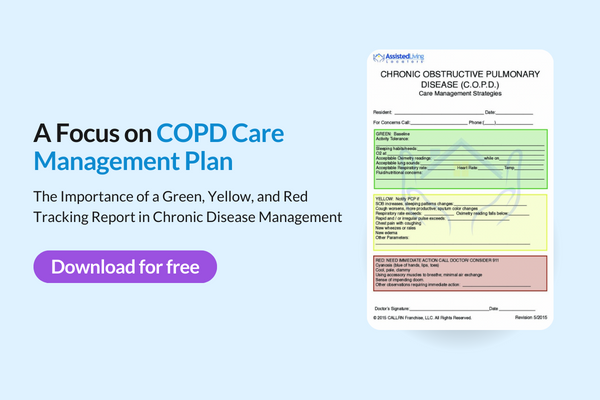Understanding Chronic Conditions for Seniors
Chronic conditions, also known as chronic diseases, are long-term health conditions that persist for more than three months and typically do not have a cure. These conditions often require ongoing management and treatment to control symptoms, prevent complications, and maintain quality of life.
Examples of common chronic conditions among seniors include:
- Arthritis
- Hypertension
- Diabetes
- Chronic obstructive pulmonary disease (COPD)
- Cardiovascular disease
- Osteoporosis
- Dementia
- Depression
Chronic conditions can have a significant impact on seniors' daily lives, affecting their physical, mental, and emotional well-being. These conditions may limit mobility, cause pain, fatigue, and reduce the ability to perform daily activities such as dressing, bathing, and cooking. Chronic conditions can also lead to isolation and loneliness, as seniors may have difficulty socializing or participating in activities they once enjoyed.
The management of chronic conditions can also be costly and time-consuming, with older adults often requiring regular doctor visits, medications, and specialized equipment such as walkers or wheelchairs. Furthermore, chronic conditions can increase the risk of falls, hospitalizations, and other health complications, which can further disrupt seniors' lives and reduce their independence.
Tips for Managing Chronic Conditions for Seniors
Managing chronic conditions can be challenging for seniors, but there are several ways to improve their quality of life and reduce the impact of these conditions. Here are some tips for managing chronic conditions in seniors:
- Adhere to medication schedules and doctor's appointments: It's essential to follow the medication schedule prescribed by a doctor and attend regular check-ups to monitor the condition's progress. Skipping medication or appointments can lead to a worsening of symptoms and complications.
- Maintain a healthy lifestyle: Eating a balanced diet and engaging in regular exercise can help seniors manage their chronic conditions. A diet rich in fruits, vegetables, lean protein, and whole grains can help reduce inflammation and control blood sugar levels. Regular exercise can improve strength, balance, and cardiovascular health.
- Seek emotional support: Managing a chronic condition can be emotionally challenging for seniors. It's important to have emotional support from family members, friends, or healthcare professionals. Therapy or support groups can also help seniors manage their emotional well-being.
- Manage stress: Chronic conditions can cause stress, and managing stress can help improve overall health. Engaging in activities such as meditation, deep breathing, or yoga can help reduce stress levels.
- Stay active: Engaging in activities such as hobbies, socializing, or volunteering can help seniors stay active and engaged in their community. This can improve mental health and reduce the impact of chronic conditions.
Managing Specific Chronic Conditions
Managing specific chronic conditions requires a tailored approach that takes into account the unique needs and circumstances of each individual. Here are some pieces of advice for managing common chronic conditions among seniors:
Diabetes
To manage diabetes, seniors should focus on maintaining healthy blood sugar levels through diet, exercise, and medication. It's important to follow a balanced diet that includes foods that are low in sugar and high in fiber, such as fruits, vegetables, and whole grains.
Regular exercise can help improve insulin sensitivity and lower blood sugar levels. A 2021 review published in the journal Nutrients looked at the impact of exercise on blood sugar control in older adults with type 2 diabetes. The review found that both aerobic exercise and resistance training were effective in reducing HbA1c levels (a measure of blood sugar control over time) in older adults with diabetes.
In a study recently published in the Journal of Diabetes Research, researchers discovered a correlation between increased physical activity and elevated levels of insulin-like growth factor (IGF-1) and brain-derived neurotrophic factor (BDNF) in the bloodstream. According to Kendra Davis-Plourde, the co-author and doctoral candidate, this evidence suggests that physical activity may play a critical role in reducing the risk of cardiovascular disease and dementia in individuals with diabetes. As a result, people with diabetes should strive to maintain an active lifestyle as they age.
Seniors with diabetes should also work closely with their healthcare provider to monitor their blood sugar levels regularly.
Arthritis
Seniors with arthritis should focus on reducing pain and inflammation. Low-impact exercises such as walking, swimming, or yoga can help improve joint mobility and reduce pain. Heat or cold therapy can also help reduce inflammation and pain.
Elders with arthritis should also work with their healthcare provider to develop a medication plan that can help reduce pain and inflammation.
Hypertension
Older adults with hypertension should focus on reducing their blood pressure through lifestyle changes and medication. Eating a diet that is low in salt and high in potassium-rich foods can help lower blood pressure.
Regular exercise can also help lower blood pressure. Seniors with hypertension should also work closely with their healthcare providers to monitor their blood pressure regularly and adjust medication as necessary.
Dementia
Seniors with dementia require specialized care that takes into account their cognitive decline. Caregivers should focus on creating a safe and structured environment that reduces confusion and anxiety.
It's important to encourage activities that promote mental stimulation and socialization, such as puzzles or group activities. The Journal of Clinical Nursing published an article in 2020 stating that exercise can have a positive impact on the cognitive function and daily activities of patients with mild to moderate dementia. The study included 21 randomized controlled trials with 1,015 participants. Exercise interventions were found to have a moderate effect size of 0.43 in improving cognitive function. These results suggest that exercise interventions could be a non-drug approach to managing dementia symptoms.
Seniors with dementia should also work with their healthcare provider to develop a medication plan that can help manage their symptoms.
Older adults should work closely with their healthcare providers to create an individualized plan for managing chronic conditions. This plan should take into account the unique needs and circumstances of each individual and should be regularly reviewed and adjusted as needed. By working with their healthcare provider, seniors can improve their quality of life and manage their chronic conditions more effectively.
Free Tool: Know Your Zone-The Importance of Green, Yellow, and Red
Managing a chronic disease like COPD can be challenging, especially when symptoms can fluctuate and worsen over time. That's where a green, yellow, or red tracking report can be a helpful tool.
This report is color-coded to indicate different levels of health status: green for normal or baseline, yellow for warning or cautionary, and red for critical or emergency. By monitoring various parameters, such as activity tolerance, sleeping habits, oxygen therapy, oximetry readings, lung sounds, respiratory rate, heart rate, temperature, fluid and nutritional concerns, and others, individuals and caregivers can quickly identify early warning signs and take necessary action to prevent exacerbations or deterioration of their health.
For instance, the care management plan for COPD provides a structured approach to monitoring and addressing the respiratory needs of the individual, with the green zone indicating baseline parameters, the yellow zone indicating when to notify the primary care physician (PCP), and the red zone indicating when immediate action is needed.
It's important to customize the tracking report for each individual based on their specific needs and symptoms and to regularly track and document the parameters to better understand disease progression and adjust the treatment plan accordingly.
The green, yellow, and red tracking report is a valuable tool for managing chronic diseases and can empower older adults and caregivers to take control of their health by identifying early warning signs and preventing more severe outcomes.
Technology and Chronic Condition Management
Technology has transformed the healthcare industry and has become a powerful tool in managing chronic conditions, especially for seniors. Here are some ways technology can aid seniors in managing their chronic conditions:
Medication reminders
Technology can help seniors remember to take their medications on time by setting up reminders on their smartphones or smartwatches. This is particularly useful for seniors who have multiple medications to take throughout the day.
Telemedicine appointments
Technology allows seniors to connect with their healthcare providers remotely. Telemedicine appointments can be conducted via video conferencing, phone calls, or messaging apps. This is especially helpful for seniors who have difficulty traveling to medical appointments.
Wearable devices
Wearable devices such as fitness trackers and smartwatches can help seniors monitor their physical activity, heart rate, and sleep patterns. This information can be shared with their healthcare provider to help them better manage their chronic condition.
Online support groups
Online support groups provide a platform for seniors to connect with others who are going through similar experiences. This can be helpful for seniors who may feel isolated or alone in managing their chronic condition.
Benefits of technology in managing chronic conditions:
- Improved access to healthcare: Technology enables seniors to connect with their healthcare providers from the comfort of their own homes. This can save time and money, especially for seniors who live in rural or remote areas.
- Better communication: Technology can improve communication between seniors and their healthcare providers. This can lead to more personalized and effective treatment plans.
- Increased independence: Technology can help seniors manage their chronic conditions independently, which can improve their quality of life and overall well-being.
Limitations of technology in managing chronic conditions:
- Technology can be costly: Many of the technologies used in managing chronic conditions, such as wearable devices, can be expensive. This may be a barrier for seniors who have limited financial resources.
- Technology can be complicated: seniors who are not tech-savvy may find it difficult to use technology to manage their chronic conditions.
- Lack of personal touch: Technology cannot replace the personal touch of a healthcare provider. Seniors may miss the face-to-face interaction that comes with in-person medical appointments.
Wrapping Up Tips on Managing Chronic Conditions for Seniors
Chronic conditions, also known as chronic diseases, are long-term health conditions that persist for more than three months and typically do not have a cure. Examples of common chronic conditions among seniors include arthritis, hypertension, diabetes, chronic obstructive pulmonary disease (COPD), cardiovascular disease, osteoporosis, dementia, and depression.
Se with chronic conditions often require ongoing management and treatment to control symptoms, prevent complications, and maintain their quality of life. These conditions can have a significant impact on seniors' daily lives, affecting their physical, mental, and emotional well-being. Chronic conditions can limit mobility, cause pain and fatigue, and reduce the ability to perform daily activities such as dressing, bathing, and cooking. Managing chronic conditions can also be costly and time-consuming, with seniors often requiring regular doctor visits, medications, and specialized equipment such as walkers or wheelchairs. Furthermore, chronic conditions can increase the risk of falls, hospitalizations, and other health complications, which can further disrupt seniors' lives and reduce their independence.
To manage chronic conditions effectively, seniors need to work closely with their healthcare providers to create an individualized plan that takes into account the unique needs and circumstances of each individual. The management of specific chronic conditions requires a tailored approach that includes medication, lifestyle changes, and regular monitoring. In addition, technology can aid seniors in managing their chronic conditions, with medication reminders, telemedicine appointments, wearable devices, and online support groups being particularly helpful.






